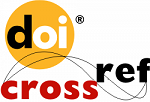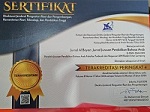The Effectiveness of Grammatical Hunting Game Method Students’ Arabic Learning Motivation
Abstract
Keywords
Full Text:
PDFReferences
Abdurrahman, Maman, A. Suherman, Masor Masor, and Asep M. Irfan Fadhlillah. “Tantangan Guru Bahasa Arab Madrasah Aliyah Dalam Perspektif Kompetensi Pedagogik Dan Profesional.” Arabiyat : Jurnal Pendidikan Bahasa Arab dan Kebahasaaraban 2, no. 1 (July 1, 2015): 43–58.
Adilah, Nida. “Perbedaan Hasil Belajar IPA melalui Penerapan Metode Mind Map dengan Metode Ceramah.” Indonesian Journal of Primary Education 1, no. 1 (June 17, 2017): 98–103.
Al-Ghulayaini, Syaikh Musthafa. Jāmi‘u Ad-Durūs al-‘Arabiyah. Beirut-Lebanon: Darul Bayan, 2008.
Asy’ari, M. Asy’ari M. “Method Of Nahwu In Arabic Learning.” لسـانـنـا (LISANUNA): Jurnal Ilmu Bahasa Arab dan Pembelajarannya 10, no. 1 (August 27, 2020): 70–92.
Asyrofi, Syamsuddin. Metode, Strategi, Dan Permainan Edukatif Dalam Pembelajaran Bahasa Arab. Yogyakarta: Aura Pustaka, 2014.
Djamarah, Syaiful Bahri. Psikologi Pendidikan. Jakarta: Rineka Cipta, 2011.
Ehsan, Namaziandost, Shatalebi Vida, and Nasri Mehdi.“The Impact of Cooperative Learning on Developing Speaking Ability and Motivation Toward Learning English”. Journal of Language and Education. 5, no. 3 (19) (2019).
Faizah, Rohmatul. “Implementing the Method of Memorizing Vocabulary in Pushing Students to Learn Arabic.” Langkawi: Journal of The Association for Arabic and English 4, no. 1 (June 8, 2018): 65–70.
Fhonna, Rahmi, and Yunisrina Qismullah Yusuf. “Indonesian Language Learning Methods in Australian Elementary Schools.” Journal of Language and Education 6, no. 2 (June 30, 2020): 106–119.
Hilmi, Danial. “Ta’lim Al-Qawa’id Al-Nahwiyah ’Ala Asas Madkhal Al-Tanwim Al-Maghnathisi.” Arabi : Journal of Arabic Studies 2, no. 1 (August 6, 2017): 54–66.
Huda, Mokhammad Miftakhul, Pandi Rais, Agus Miftakhus Surur, and Ati’ Rohmawati. “Improvement Of Nahwu And Sharaf Learning Using Amtsilati Method.” Ijaz Arabi Journal of Arabic Learning 3, no. 1 (April 5, 2020). Accessed November 15, 2020. http://ejournal.uin-malang.ac.id/index.php/ijazarabi/article/view/6781.
Humaini, Arif. “Experimental Research: The Effectiveness of Card Game Learning Media in Learning Shorof.” Jurnal Al Bayan: Jurnal Jurusan Pendidikan Bahasa Arab 10, no. 2 (December 20, 2018): 295–307.
In’ami, Moh, and Putri Zunita Shara. “Wasilah al Lu’bah al Lughowiyah Broken Square Wa Snow Balling Fii Ta’lim al Lughoh al ‘Arabiyyah Li Tarqiyah Maharoh al Qiroah.” Jurnal Al Bayan: Jurnal Jurusan Pendidikan Bahasa Arab 10, no. 2 (December 20, 2018): 224–239.
Islam, Asep Muhammad Saepul. “Faktor Demotivasi Pembelajaran Bahasa Arab Dalam Perspektif Siswa Madrasah.” Arabiyat : Jurnal Pendidikan Bahasa Arab dan Kebahasaaraban 2, no. 1 (July 1, 2015): 1–16.
Kesumawati, Nila, Allen Marga Retta, and Novita Sari. Pengantar Statistik Penelitian. Depok: Rajawali Pers, 2017.
Latuconsina, Sarah N. “Efektivitas Permainan Bahasa Arab Dalam Meningkatkan Kemampuan Membaca Mahasiswa Program Studi Pendidikan Bahasa Arab.” Arabi : Journal of Arabic Studies 3, no. 2 (December 31, 2018): 145–156.
Maujud, Fathul, and Cipta Ningsih. “Dauru Ta’lim Qawaid al-Lughah al-Arabiyah Fi Bina’i Maharat al-Qira’ah Li al-Tullab al-Faslh al-Awwal Fi Madrasah Hikmah al-Syarif al-Aliyah Nahdlah al-Wathan Salut Narmada Lombok Barat Nusa Tenggara Barat.” Arabiyatuna : Jurnal Bahasa Arab 3, no. 1 (May 14, 2019): 65–92.
Muassomah, Muassomah, and Ma’rifatul Munjiah. “Learning Qawaid Through Language Game Adlif Kalimatan for Students of Arabic Language and Literature at UIN Maulana Malik Ibrahim Malang.” ALSINATUNA 5, no. 1 (May 15, 2020): 58–71.
Mujib, Fathul, and Nailur Rahmawati. Permainan Edukatif Pendukung Pembelajaran Bahasa Arab. Yogyakarta: Diva Press, 2012.
Mukmin, Mukmin. “The Effect Of Educational Background And Language Competence On Students’ Arabic Language Motivation.” Arabiyat : Jurnal Pendidikan Bahasa Arab dan Kebahasaaraban 6, no. 1 (June 12, 2019): 36–52.
Muslim, Ahmad Bukhori, Fuad Abdul Hamied, and Didi Sukyadi. “Integrative and Instrumental but Low Investment: The English Learning Motivation of Indonesian Senior High School Students.” Indonesian Journal of Applied Linguistics 9, no. 3 (February 10, 2020): 493–507.
Oxford, Rebecca, and Jill Shearin. “Language Learning Motivation: Expanding the Theoretical Framework.” The Modern Language Journal 78, no. 1 (1994): 12–28.
Papi, Mostafa. “Motivation As Quality: Regulatory Fit Effects On Incidental Vocabulary Learning.” Studies in Second Language Acquisition 40, no. 4 (December 2018): 707–730.
Pawlak, Mirosław. “Grammar Learning Strategies as a Key to Mastering Second Language Grammar: A Research Agenda.” Language Teaching 53, no. 3 (July 2020): 358–370.
Prasad, Pabbuleti. “Language Games - A Games Better Method of Learning Vocabularies.” 338–341. IJREAM: International Journal for Research in Engineering Application & Management, n.d.
Purwanto. Statistik Untuk Penelitian. Yogyakarta: Pustaka Pelajar, 2011.
Rahman, Nur Fuadi. “Motivasi Belajar Bahasa Arab (Studi Kasus Mahasiswa PBA IAIN Palangkaraya 2017/2018).” Jurnal Al Bayan: Jurnal Jurusan Pendidikan Bahasa Arab 10, no. 1 (June 7, 2018): 22–35.
Rahmat, Jalaludin. Metode Penelitan Komunikasi Dilengkapi Contoh Analisis Statistik. Bandung: PT Remaja Rosdakarya, 2004.
Ridlo, Ubaid. “Model Pembelajaran Bahasa Arab Materi Al-Qawa’id al-Nahwiyyah.” Al-Ma‘rifah: Jurnal Budaya, Bahasa, dan Sastra Arab 12, no. 2 (October 2, 2015): 46–57.
Rini, Rini. “Ushul al-Nahwi al-Arabi : Kajian Tentang Landasan Ilmu Nahwu.” Arabiyatuna : Jurnal Bahasa Arab 3, no. 1 (May 14, 2019): 145–162.
Ro, Eunseok, and Alfred Rue Burch. “Willingness to Communicate/Participate’ in Action: A Case Study of Changes in a Recipient’s Practices in an L2 Book Club.” Linguistics and Education 58 (August 1, 2020): 100821.
Rusady, Achmad Tito. “دوافع الطلاب في تعلم اللغة العربية و دور المعلم في ترقيتها.” Izdihar : Journal of Arabic Language Teaching, Linguistics, and Literature 1, no. 1 (September 7, 2018): 65–78.
Sanusi, Anwar, Sofyan Sauri, and Yayan Nurbayan.“Non-Native Arabic Language Teacher: Low Teacher’s Professional Competence Low Quality Outcomes?” Arabiyat : Jurnal Pendidikan Bahasa Arab Dan Kebahasaaraban 7, no. 1 (2020): 45-60.
Sardiman. Interaksi Dan Motivasi Belajar Mengajar. Jakarta: Rajawali Pers, 1986.
Sarwono, Jonathan. Statistik Itu Mudah: Panduan Lengkap Untuk Belajar Komputasi Statistik Menggunakan SPSS16. Yogyakarta: CV Andi Offset, 2009.
Subekti, Adaninggar Septi. “L2 Motivational Self System and L2 Achievement: A Study of Indonesian EAP Learners”. Indonesian Journal of Applied Linguistics 8, no. 1 (2018): 57-67.
Sulistianingsih, Endang, Rizka Febriani, and Jcs Pradjarto. “The Effect of Interactive Board Games (IBG) on Vocabulary Achievement.” Langkawi: Journal of The Association for Arabic and English 5, no. 2 (December 27, 2019): 127–139.
Uliyah, Asnul, and Zakiyah Isnawati. “Metode Permainan Edukatif Dalam Pembelajaran Bahasa Arab.” Shaut al Arabiyyah 7, no. 1 (June 27, 2019): 31–43.
Widodo, Arif. “Al-Lu’bah al-Lughawiyyah al-Namudzajiyyah Fi Ta’lim al-Kitabah.” Jurnal Al Bayan: Jurnal Jurusan Pendidikan Bahasa Arab 11, no. 1 (June 1, 2019): 111–132.
Zakiyah, Zaimatuz, and Nurul Huda. “Implementasi Metode Permainan Bahasa Grammatical Hunting Dalam Pembelajaran Bahasa Arab Di Kelas 3/1 Mutawasith Khoiriyah Wittaya Mulnithi Betong, Yala, Thailand Tahun Ajaran 2019/2020.” Jurnal Alfazuna : Jurnal Pembelajaran Bahasa Arab dan Kebahasaaraban 4, no. 2 (July 20, 2020): 212–226.
Zubaidi, Ahmad. “Development Of Mahârah Al-Istimâ’ Test Instrument For Electronic Based Arabic Student Using The Kahoot! Application.” Arabiyat : Jurnal Pendidikan Bahasa Arab dan Kebahasaaraban 7, no. 1 (June 4, 2020): 61–77.
“Peraturan Menteri Agama Republik Indonesia No. 000912 Tentang Kurikulum Madrasah 2013 Mata Pelajaran Pendidikan Agama Islam Dan Bahasa Arab,” 2013.
DOI: http://dx.doi.org/10.24042/albayan.v13i1.7344
Refbacks
- There are currently no refbacks.
Copyright (c) 2021 Jurnal Al Bayan: Jurnal Jurusan Pendidikan Bahasa Arab
License URL: https://creativecommons.org/licenses/by-sa/4.0
Editorial Office:
Jurnal Al Bayan: Jurnal Jurusan Pendidikan Bahasa Arab, Arabic Education Study Program, Faculty of Education and Teachers Training, Unversitas Islam Negeri Raden Intan Lampung
Jl. Endro Suratmin 1 Sukarame, Bandar Lampung 35131-Indonesia
e-mail: jurnalalbayan@radenintan.ac.id
http://ejournal.radenintan.ac.id/index.php/albayan/index
Jurnal Al Bayan: Jurnal Jurusan Pendidikan Bahasa Arab is licensed under a Creative Commons Attribution-ShareAlike 4.0 International License. p-ISSN 2086-9282 | e-ISSN 2549-1229









